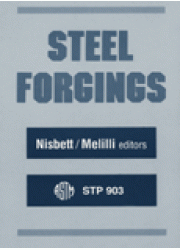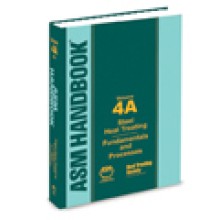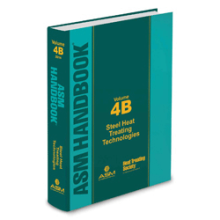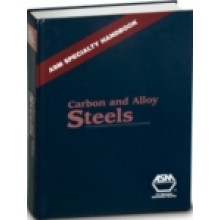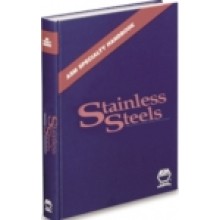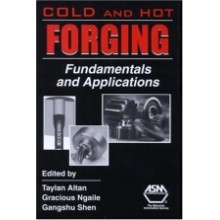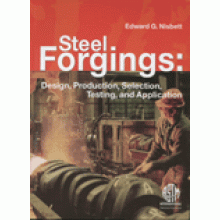Steel Forgings STP 903
Quantity:
-
Add to Compare
Covers all of the salient manufacturing stages on which the production of quality forgings depends, namely, steel melting, refining and remelting procedures, control of segregation and solidification in both large and specialized ingots, forging procedures, and achievements which contribute to improved integrity in response to application demands.
Turbine and Generator Forgings
Chapter 1 : The Development of Improved Forgings for Modern Steam Turbines
Chapter 2 : Influence of Advanced Steelmaking Technology on Specification Trends for Rotor Forgings
Chapter 3 : The Effect of Alloying Elements and Steelmaking Processes on The “A” Segregation Occurrence in Large Ingots
Rotor Manufacture
Chapter 4 : Development of Integral High-Pressure–Low-Pressure Combination Rotor Forgings
Chapter 5 : Manufacture of Differentially Heat-Treated Turbine Rotor Forgings
Chapter 6 : Manufacturing of Welded Polyblock Turbine Rotors for Pressurized Water Reactor Nuclear Plants; Optimization of The Steel Grade; Effect of Impurities
Chapter 7 : New 2Cr-Mo-Ni-W-V Steel for High-Pressure Rotors
Chapter 8 : Mechanical Properties of Advanced Technology 1Cr-Mo-V Steam Turbine Rotor Forgings
Chapter 9 : Soft-Martensitic Stainless Cr-Ni-Mo Steel for Turbine Rotors in Geothermic Power Stations
Rotor Assessment
Chapter 10 : Metallurgical Analysis of Flaws in Carbon-Molybdenum and Nickel-Molybdenum-Vanadium Turbine Rotor Forgings
Chapter 11 : The Fracture Toughness of Actual and Simulated Large Rotor Forgings Made from 3.5Ni Steel
Chapter 12 : Integrity of Full-Integral, Low-Pressure Nuclear Turbine Forgings
Chapter 13 : In-Service Inspection Test and Evaluation Techniques for Large Generator Rotors
Generator Retaining Rings
Chapter 14 : The Development of New Materials for Nonmagnetizable Retaining Rings and Other Applications in The Power Generating Industry
Chapter 15 : 18–18 Corrosion-Resistant Retaining Rings for Nuclear Power Plant Generators
Pressure Vessel and Nuclear Forgings
Chapter 16 : Seamless Shell Course Forgings For Heavy-Wall Reactor Vessels: A Forgemaster's Critical Review
Chapter 17 : Evaluation of Modified 9Cr-1Mo Steel Forging
Chapter 18 : Evaluation of The Modified 9Cr-1Mo Steel Forging by French Laboratories
Chapter 19 : Optimizing Mechanical Properties of Specialty, Stainless, and Heat-Resistant Alloy Steel Forgings by Thermomechanical Processing
Forging Processing for Pressure Vessel and Nuclear Application
Chapter 20 : Application of New Types of Ingots to The Manufacturing of Heavy Pressure Vessel Forgings
Chapter 21 : Integral Forged Pump Casing for The Primary Coolant Circuit of A Nuclear Reactor: Development in Design, Forging Technology, and Material
Chapter 22 : Manufacturing of Large and Integral-Type Steel Forgings for Nuclear Steam Supply System Components
Chapter 23 : Advanced Technology of Heavy-Section Tube Sheets for Nuclear Power Generation
Chapter 24 : Best Possible Heat Treatment of Steel SA 336 F22 for The Production of Forged Shells with Heavy Walls
Chapter 25 : Production of A 304 Stainless Steel Nuclear Reactor Forging from A Very Large Electroslag Refined Ingot
General Industrial Forgings
Chapter 26 : Survey of New Developments in Forging Techniques and Equipment
Chapter 27 : Forging Force Requirements with Special Regard to Shear Resistance of The Forge Material
Chapter 28 : Forging of Long-Stroke Crankshafts by The TR Method
Manufacture and Application
Chapter 29 : Cryogenic Mechanical Properties of A286 Alloy and 304LN Stainless Steel Used in Fabrication of Support Struts for Superconducting Magnets
Chapter 30 : Steel Forgings for a Tension Leg Platform Anchoring System¯The Design and Management Contractor's Experience of Their Manufacture and Testing
Test Methods and Forging Assessment
Chapter 31 : High-Sensitivity, Immersion, Ultrasonic Testing of Steel Forgings
Chapter 32 : Hydrogen¯Its Occurrence, Determination, and Control in Steel Forgings
Chapter 33 : Failure Analysis of Hot Forging Dies
Author Index
Subject Index
Write a review
Your Name:Your Review: Note: HTML is not translated!
Rating: Bad Good
Enter the code in the box below:
Copyright © 2014 Engineering Standards Bureau. All Rights Reserved.
Developed By Zoom Into Web


